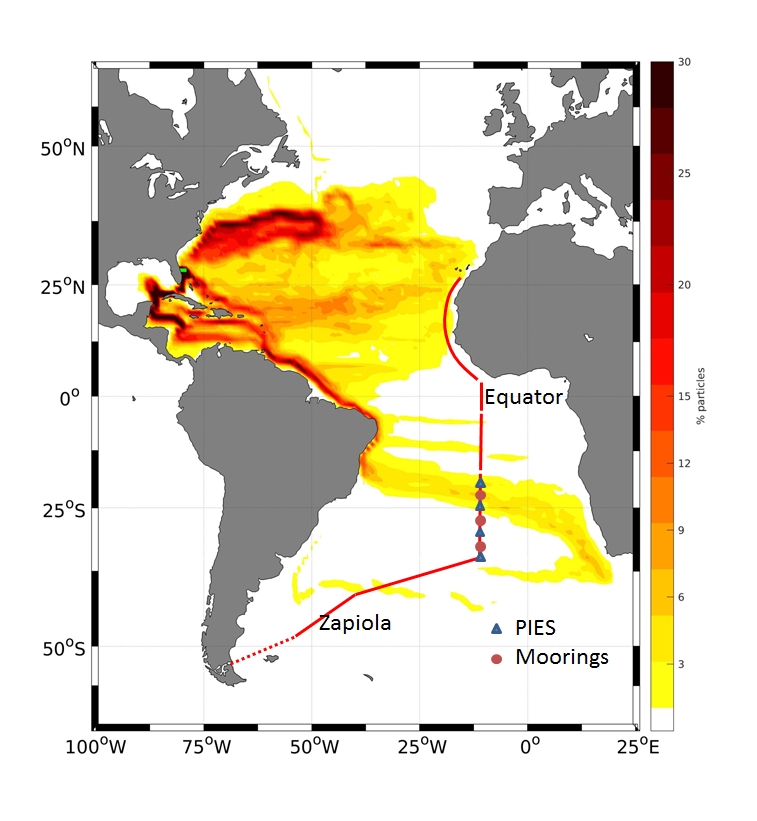A series of devices will be deployed to measure different oceanographic variables at a depth of between 2 and 4 kilometres at seven locations between 34 and 19ºS along the 10ºW meridian.

To better understand the functioning of the global overturning circulation and its influence on the Earth's climate, a group of researchers led by experts from the Institut de Ciències del Mar (ICM-CSIC), the University of Las Palmas (ULPGC) and the Spanish Institute of Oceanography (IEO), among other international centres, has launched the SAGA (South Atlantic Gateway) project, funded by the Spanish National R&D&I Plan.
The global overturning circulation or global ocean conveyor belt is part of the large-scale ocean circulation. About half of this conveyor belt originates in the northern Atlantic, where deep waters are formed and travel southwards until they reach the Antarctic Circumpolar Current, which transfers them to the rest of the oceans.
This deep flow is compensated by waters that circulate closer to the surface, crossing the South Atlantic westwards until arriving to the tropical regions. From there they eventually reach the Gulf Stream, which originates in the Gulf of Mexico, and reach the deep water formation zones in the Arctic subpolar gyre, above Newfoundland and the British Isles.
This makes the South Atlantic a true crossroad that regulates the strength of the global overturning circulation, a key component of the climate system responsible for transporting warm waters northward and cold waters southward. In the South Atlantic, deep currents cross the Atlantic ridge eastward, while shallower and intermediate currents travel westward.
A major campaign
The research team involved in the project departed in early March from the Port of Punta Arenas (Chile) as part of the SAGA10W oceanographic campaign and will arrive in Gran Canaria (Spain) at the end of April. During this period, different devices will be installed on the seabed to find out how the South Atlantic currents behave and how they are connected to the Southern Ocean, the one that bathes Antarctica.
"At present, we know fairly well surface currents and how they distribute heat to the different regions of the planet thanks to satellites, but we have very little information on the deep currents, which are key to the functioning of the oceanic conveyor belt", states Mikhail Emelianov, the head of the SAGA10W campaign on board the oceanographic vessel Sarmiento de Gamboa.
During the campaign, a series of devices will be deployed to measure different oceanographic variables at a depth of between 2 and 4 kilometres at seven locations located between 34 and 19ºS along the 10ºW meridian: 4 PIES (Pressure Inverted Echo Sounder) - which allow reconstructing the thermohaline structure of the water column - and 3 moorings with built-in current meters and CTDs - measuring the temperature, salinity and conductivity of the water.

The moorings will be in the water for two years. Then, the data will be collected to be analysed. The PIESs, on the other hand, will remain on the seabed for four years, but after 16 and 32 months, some units will be released and will rise to the sea surface to transmit the collected data.
"Thanks to this equipment, we will be able to measure the amount of water exchanged between the tropical and sub-Antarctic regions uninterruptedly for several years", explains the ICM director Josep Lluís Pelegrí, one of the researchers involved in the project. In his opinion, "the deployment of this equipment is totally innovative and will greatly improve the international community's ability to measure and understand the functioning of the global conveyor belt".
"SAGA will set Spain in a reference position in terms of marine current monitoring, thus fostering collaborations with other marine research centres in Spain, the United States, France, South Africa, Brazil, Argentina and Germany, among others," conclude the project's researchers.
In addition to the ICM, the ULPGC and the IEO, the Marine Technology Unit (UTM), the University of Barcelona (UB), the Autonomous University of Barcelona (UAB), the Ensenada Centre for Scientific Research and Higher Education (CICESE) in Mexico, the Pierre et Marie Curie University (France) and the University of Cape Town (South Africa) are also participating in this initiative.